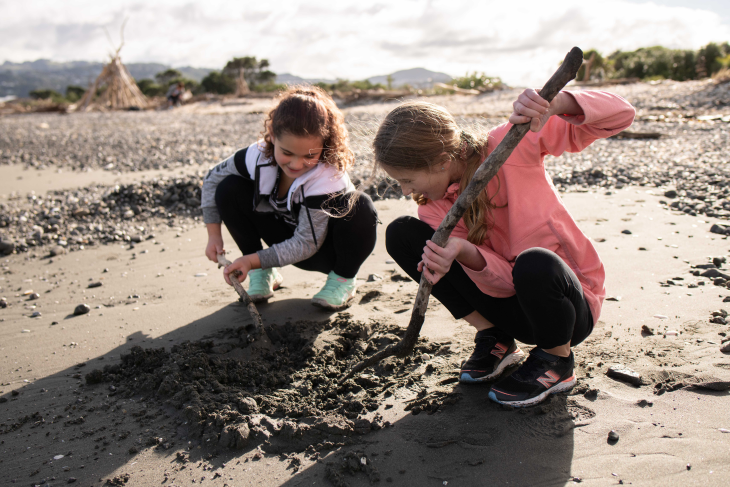Agree with your thinking
Learning the hard way: The surprising reasons our tamariki get injured

Keeping our little ones safe while allowing them to learn is a balancing act. When it comes to tamariki safety, there is more going on than meets the eye.
We're all familiar with the bumps and scrapes that come with being a kid. Learning by doing is all part of a healthy and balanced childhood. But as those caring for our tamariki, we also have a responsibility to help keep that balance in check.
We know that 90% of injuries are preventable, and injury claims for tamariki have been decreasing over the past two years. And while we expect to always support our youngest as they bump and scrape their way through childhood, we want to keep that trend heading in the right direction.
It’s not about getting out the cotton wool. Instead, education is the best step forward for our tamariki. When they learn how to assess risk at a young age, they take it with them through life as they navigate different challenges.
We looked into our injury data to see how our tamariki are hurting themselves accidentally. While the injuries themselves may seem familiar, why they’re happening tells an interesting story.
For tamariki, in the last five years
In that same time,
Falling into a pattern
In 2020, the ground was where our tamariki were most commonly finding harm. Soft tissue injuries (bruises) made up 43% of all our claims for those under 14, so it’s no surprise that falls are the most common cause of injury.
What may surprise you are the secondary injuries that can come with a fall. While our tamariki are still learning about their environment, they rely on key instincts that can cause more harm than good. This is particularly important for those aged 5 and under.

When they fall, young ones will go to any length to save themselves from a tumble. This often means they reach out for the nearest item to grab, but don’t quite know that what they’re grabbing can cause more harm.
If they were to fall over in the kitchen, your tamariki may reach for a hot oven or boiling kettle to hold themselves up. Or if they fall in the garden, they may reach out to grab a splintery piece of wood to stop their fall.
Falls are common, so it’s important to check your tamariki's environment. Parents can do this easily to prevent any secondary injuries occurring when they do go down. See our top tips on setting up your home safely below.
Spotting the hazards
Your home or a school classroom may look like a hazard-free zone, and as they try new environments, our tamariki really put that to the test when they explore. We already know that falls are common, but the second and third-place holders might surprise you.
Cuts and stings come in second, and bone breaks and fractures are the third-most common injury for our tamariki.
To understand why these may happen we have to think like our tamariki. It’s much harder for them to know whether the piece of furniture they’re about to climb is well-secured. In the garden, they may not know that a tree branch won't hold their weight as they climb.
This is sometimes a hard part of learning for the young ones. As adults, we can think about how the environments our tamariki spend their time in are set up for safety.

Swallowing the pain
Everyone has a story of a time they ate or swallowed something they shouldn't have. It’s very common, especially for toddlers. As our tamariki grow, they go through phases of thinking they’re invincible and often act on impulse.
Over 6.5% of our tamariki's injuries are for dental injuries, putting foreign objects in their body, or swallowing something they shouldn’t.
While this data is from injury claims we’ve had, this situation can often have more serious consequences. Knowing what shouldn’t go in the mouth is a small and important part of their young learning.

External factors
Our tamariki love to explore and try new things in their shiny and new world. While injuries tell us part of the story, other external factors can also play a part.
While cuts, lacerations and stings make up 27% of all tamariki injuries, only 8% of all injuries involved a live animal. While soft tissue injuries make up 43% of the total, it may surprise you that only 6% of all injuries involved a playground.
It’s easy to take steps to set our homes and classrooms up to prevent our tamariki from finding harm. Sometimes external factors are harder to prepare for, but it's not impossible.
When it comes to injury prevention, all the places outside of home that kids enjoy make great learning opportunities. Learning alongside an adult can help our tamariki in the long run.

Following the leader
One thing all parents know is that our tamariki will copy what they see older people around them doing.
Whether it’s riding a bike on the road like an older sibling, or cooking a meal like mum and dad, tamariki want to have a go.
From 2016-2020, bumps and falls, cuts and stings and bone breaks or fractures made up 81% of tamariki injuries. As our children love to copy what older ones around them do, it's a great opportunity to use that to your advantage.
Taking time to help your tamariki learn about preventing injuries will serve them for life. When they see that attitude around them, behaviour change will follow. Use this time to give them skills that will keep them safe for the rest of their lives.
Head to Safekids Aotearoa for more advice on keeping your tamariki safe while still enjoying everything the world has to offer.
Key insights for tamariki safety:
- Over the last 5 years, just under 50% of claims for those under 14 occurred at home. This is a good chance to see how your home can be set up for safety.
- The most injury-dense time of year is Autumn.
- Homes are the leading location for injury, with schools and sports centres following that.
- Recreation and sporting activities lead the category of what our tamariki were doing before getting injured.





